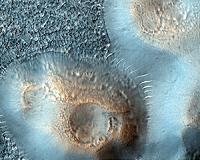 |
Washington (UPI) Sep 3, 2010 New analysis of data sent from Mars 34 years ago showing there was no organic material on the planet suggests maybe there was after all, U.S. scientists say. Researchers say the result from re-examining findings of the 1976 Viking mission does not bring scientists closer to discovering life on Mars, but it does increase likelihood that life exists, or once existed, on the planet, The Washington Post reported. The findings demonstrate the risk of "false negatives" in space exploration based on limitations of the equipment used and on scientists' assumptions about conditions beyond Earth, Mary Voytek, senior scientist for astrobiology at NASA, said "We can now say there is organic material on Mars, and that the Viking organics experiment that didn't find any had most likely destroyed what was there during the testing," said Rafael Navarro-Gonzalez of the National Autonomous University of Mexico, who performed a re-creation of the original testing. Researchers replicated the Viking mission with soil from the most Mars-like environment on Earth -- the Atacama Desert in Chile -- and heated the sample in the same way it was heated by the Viking instruments on Mars. The small amount of organic material known to be in the Atacama soil was detectable low temperatures, but was broken up into water and carbon dioxide when heated. But the tests always produced other evidence of organic material, evidence discounted in the original Viking mission. "The big lesson here, and the great importance of this finding, is that we have to know what we're looking for and how we can find it," Voytek said. "It shows that we could actually uncover life on Mars and not know it."
Share This Article With Planet Earth
Related Links Mars News and Information at MarsDaily.com Lunar Dreams and more
 Martian 'mud' volcanoes eyed for life
Martian 'mud' volcanoes eyed for lifeWashington (UPI) Aug 19, 2010 Researchers say if life existed on Mars, the best place to look today is a region rich in what they say were mud volcanoes spewing sediment from underground. An area of the planet's northern plains called Acidalia Planita contains thousands of the circular mounds, formed from ancient sediment that might contain evidence of possible past or present life, Astrobiology magazine reports. ... read more |
|
| The content herein, unless otherwise known to be public domain, are Copyright 1995-2010 - SpaceDaily. AFP and UPI Wire Stories are copyright Agence France-Presse and United Press International. ESA Portal Reports are copyright European Space Agency. All NASA sourced material is public domain. Additional copyrights may apply in whole or part to other bona fide parties. Advertising does not imply endorsement,agreement or approval of any opinions, statements or information provided by SpaceDaily on any Web page published or hosted by SpaceDaily. Privacy Statement |